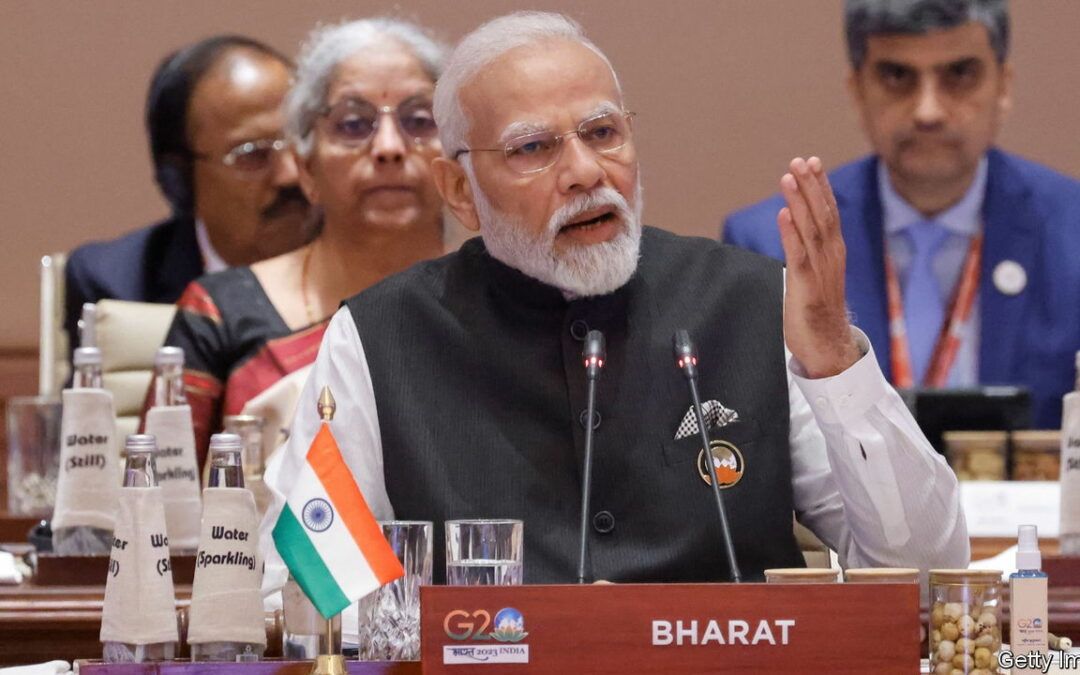EVER SINCE the Bharatiya Janata Party (BJP) came to power in 2014 it has implemented policies to mould India according to its Hindu-nationalist vision. Now it may be poised to implement the most eye-catching change yet: renaming the country. During the G20 summit in Delhi, on September 9th and 10th, Narendra Modi, the prime minister, sat behind a nameplate inscribed with “Bharat”, the Hindi name for India.
The use of Bharat throughout the summit sparked frenzied conjecture. Mr Modi has not commented on the matter, but his government’s announcement of a “special session” of Parliament from September 18th has fuelled speculation that a change may be imminent. On September 14th the government released a feeble agenda for the session that did little to quell the rumours. Why might the BJP want to rebrand India?
Bharat is already a widely used synonym for India, at least within the country. The constitution begins with the phrase “India, that is Bharat”. The national anthem uses the name too. The word’s etymological roots are in Sanskrit, an ancient language from which most modern Indian tongues have emerged. Consequently, the country is referred to as Bharat in most local vernaculars.
For many BJP supporters, the term connotes a halcyon Hindu era. Scholars believe it was first used more than 2,000 years ago in reference to a tribe called Bharata that populated northern India. It features prominently in Hindu mythology: Bharata is said to be a king who conquered the subcontinent and established an eponymous empire.
The BJP’s preference for Bharat also reflects a deep resentment of colonial rule. India was the name Britain used to refer to the vast and disparate cornerstone of its empire. One BJP MP has likened the name to a profanity because of the colonial association. Such hyperbole is not new. Over the years, the BJP and its predecessors have renamed cities and streets to remove connections to periods of subjugation. But although the name India may be associated with British rule, its use far predates that period. The ancient Greeks are believed to have called the subcontinent “Indus”, in reference to the river that flows through it. “Indus” itself comes from a Sanskrit word for the river, sindhu.
The BJP’s opponents believe there is a more prosaic reason for the sudden push for Bharat. They reckon that Mr Modi and his colleagues have been rattled by a recently formed coalition of more than two dozen opposition parties ahead of the general election in 2024. The group, dubbed the Indian National Developmental Inclusive Alliance, goes by the acronym INDIA. Rahul Gandhi, the main opposition leader, claims the proposed rebranding is being used to distract Indians from problems created by Mr Modi’s government.
If the BJP is serious about the change, implementing it will be difficult. It would require a constitutional amendment, and therefore two-thirds of the vote in each of the two houses of parliament. That means the government would have to rely on the opposition, which would be unlikely to support any BJP proposal. Attempts by local groups and private citizens to change India’s name through the courts have also failed. In 2020 the Supreme Court dismissed an appeal arguing that renaming was in the public interest. And even if the BJP succeeds, the change would come at a big cost. At the time of independence, nationalists chose to retain India in part because the name was familiar to the rest of the world. Building a new association would be hard. Mr Modi should know. One of his first acts as prime minister was to launch a programme seeking foreign investment. It is called “Make in India”. ■









